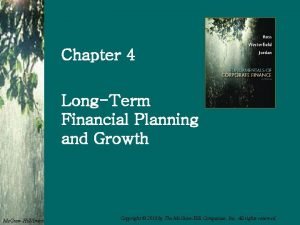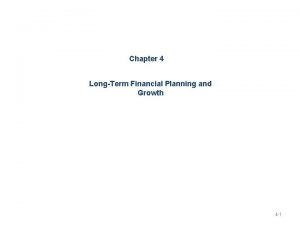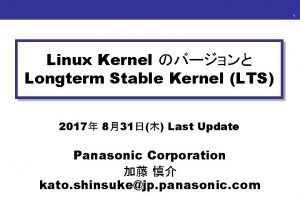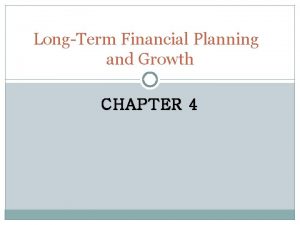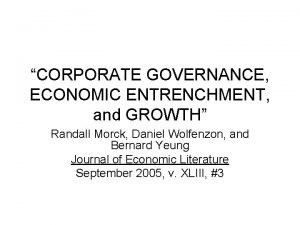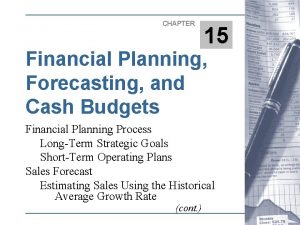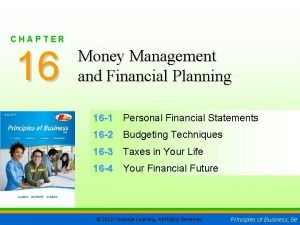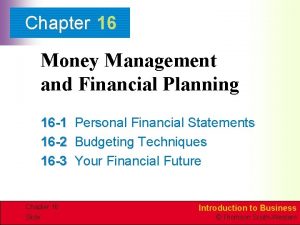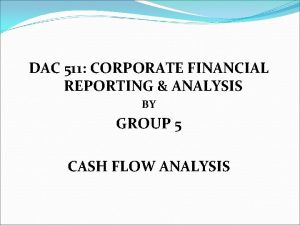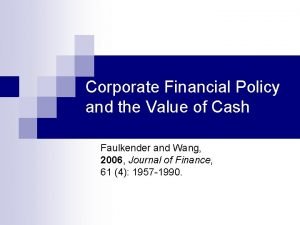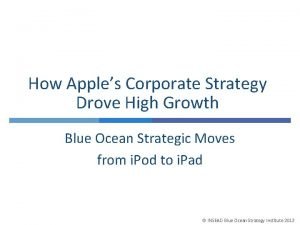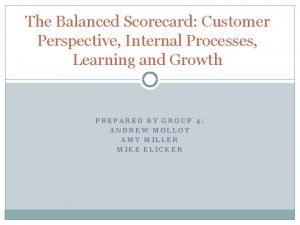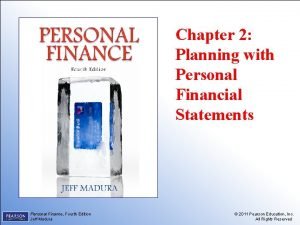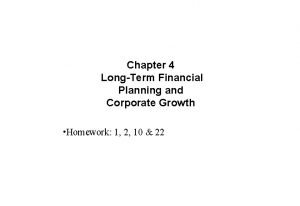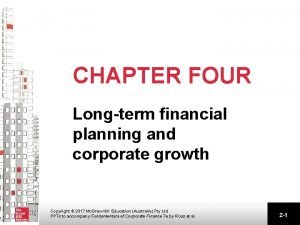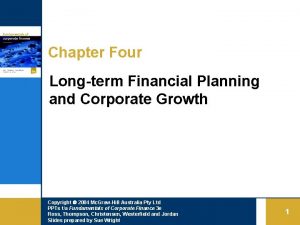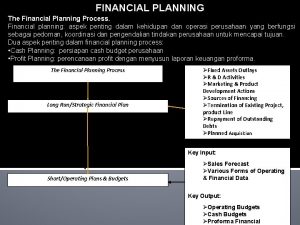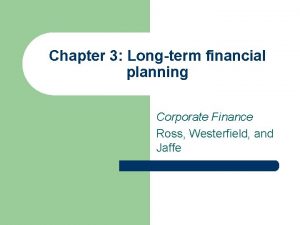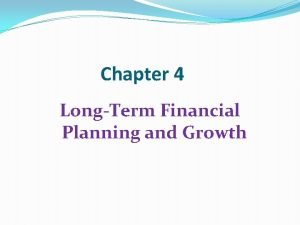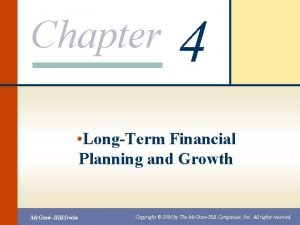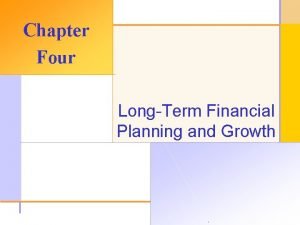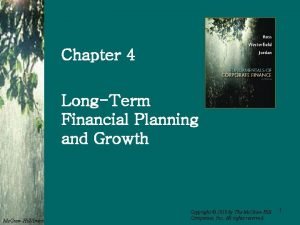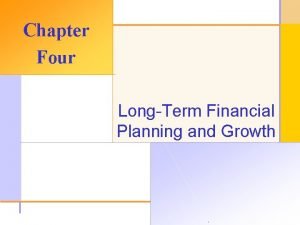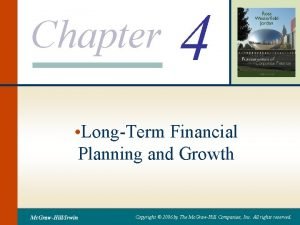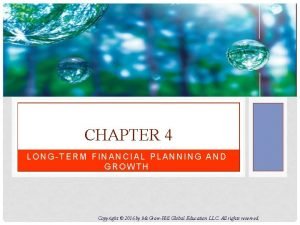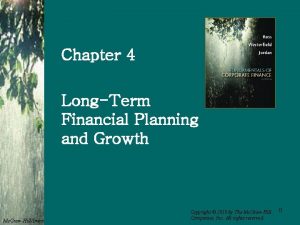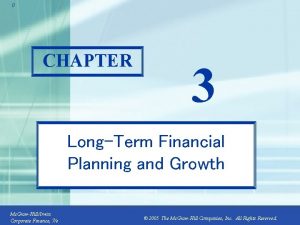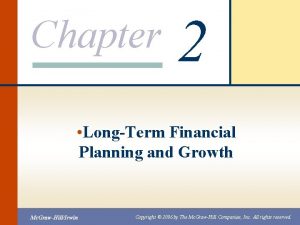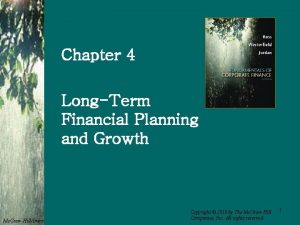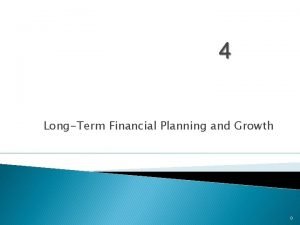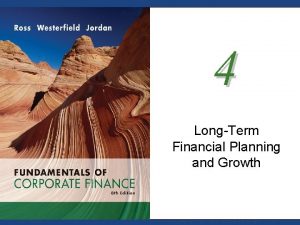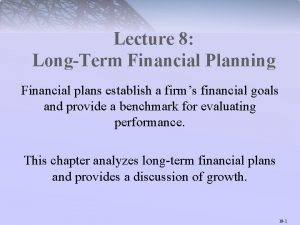Chapter 4 LongTerm Financial Planning and Corporate Growth



























- Slides: 27

Chapter 4 Long-Term Financial Planning and Corporate Growth Prepared by Anne Inglis Mc. Graw-Hill Ryerson © 2013 Mc. Graw-Hill Ryerson Limited

Key Concepts and Skills • Understand the objective and goal of financial planning • Know how to compute the external financing needed to fund a firm’s growth • Be able to develop a financial plan by applying the percentage of sales approach • Know the determinants of a firm’s growth • Be able to compute the sustainable and internal growth rates • Understand some of the problems in planning for growth © 2013 Mc. Graw-Hill Ryerson Limited 4 -1

Chapter Outline • • • What is Financial Planning? Financial Planning Models: A First Look The Percentage of Sales Approach External Financing and Growth Some Caveats On Financial Planning Models • Summary and Conclusions © 2013 Mc. Graw-Hill Ryerson Limited 4 -2

LO 1 Basic Elements of Financial Planning • Investment in new assets – determined by capital budgeting decisions • Degree of financial leverage – determined by capital structure decisions • Cash paid to shareholders – dividend policy decisions • Liquidity requirements – determined by net working capital decisions © 2013 Mc. Graw-Hill Ryerson Limited 4 -3

LO 1 Financial Planning Process 4. 1 • Planning Horizon - divide decisions into short-run decisions (usually next 12 months) and long-run decisions (usually 2 – 5 years) • Aggregation - combine capital budgeting decisions into one big project • Assumptions and Scenarios • Make realistic assumptions about important variables • Run several scenarios where you vary the assumptions by reasonable amounts • Determine at least a worst case, normal case and best case scenario © 2013 Mc. Graw-Hill Ryerson Limited 4 -4

LO 1 Role of Financial Planning • Examining interactions – helps management see the interactions between decisions • Exploring options – gives management a systematic framework for exploring its opportunities • Avoiding surprises – helps management identify possible outcomes and plan accordingly • Ensuring Feasibility and Internal Consistency – helps management determine if goals can be accomplished and if the various stated (and unstated) goals of the firm are consistent with one another © 2013 Mc. Graw-Hill Ryerson Limited 4 -5

LO 3 Financial Planning Model Ingredients 4. 2 • Sales Forecast – many cash flows depend directly on the level of sales (often estimated using a growth rate in sales) • Pro Forma Statements – setting up the financial plan in the form of projected financial statements allows for consistency and ease of interpretation • Asset Requirements – how much additional fixed assets will be required to meet sales projections © 2013 Mc. Graw-Hill Ryerson Limited 4 -6

LO 3 Ingredients Continued • Financial Requirements – how much financing will we need to pay for the required assets • Plug Variable – management decision about what type of financing will be used (makes the Statement of Financial Position balance) • Economic Assumptions – explicit assumptions about the coming economic environment © 2013 Mc. Graw-Hill Ryerson Limited 4 -7

LO 3 Example 1 – Historical Financial Statements Gourmet Coffee Inc. Statement of Financial Position December 31, 2011 Assets 1000 Debt Equity Total 1000 Total 400 600 1000 © 2013 Mc. Graw-Hill Ryerson Limited 4 -8

LO 3 Example 1 continued – Historical Statement of Comprehensive Income Gourmet Coffee Inc. Statement of Comprehensive Income For Year Ended December 31, 2011 Revenues 2000 Costs 1600 Net Income 400 © 2013 Mc. Graw-Hill Ryerson Limited 4 -9

LO 3 Example 1 continued - Pro Forma Statement of Comp. Income • Initial Assumptions • Revenues will grow at 15% (2000*1. 15) • All items are tied directly to sales and the current relationships are optimal • Consequently, all other items will also grow at 15% Gourmet Coffee Inc. Pro Forma Statement of Comprehensive Income For Year Ended 2012 Revenues 2, 300 Costs Net Income 1, 840 460 © 2013 Mc. Graw-Hill Ryerson Limited 4 -10

LO 3 Example 1 continued - Pro Forma Statement of Financial Position • Case I Gourmet Coffee Inc. • Dividends are the plug Pro Forma Stmt. of Fin. Position variable, so debt and Case 1 equity increase at 15% • Dividends = 460 NI – Assets 1, 150 Debt 460 90 increase in equity = 370 Equity 690 Total 1, 150 © 2013 Mc. Graw-Hill Ryerson Limited 4 -11

LO 3 Example 1 continued - Pro Forma Statement of Financial Position • Case II Gourmet Coffee Inc. • Debt is the plug variable and no dividends are paid • Debt = 1, 150 – (600+460) = 90 • Repay 400 – 90 = 310 in debt Pro Forma Stmt. of Fin. Position Case 1 Assets 1, 150 Debt Equity Total 1, 150 Total 90 1, 060 1, 150 © 2013 Mc. Graw-Hill Ryerson Limited 4 -12

LO 3 Percent of Sales Approach 4. 3 • Some items tend to vary directly with sales, while others do not • Statement of Comprehensive Income • Costs may vary directly with sales • If this is the case, then the profit margin is constant • Dividends are a management decision and generally do not vary directly with sales – this affects the retained earnings that go on the Statement of Financial Position © 2013 Mc. Graw-Hill Ryerson Limited 4 -13

LO 3 Percentage of Sales Approach Continued • Statement of Financial Position • Initially assume that all assets, including fixed, vary directly with sales • Accounts payable will also normally vary directly with sales • Notes payable, long-term debt and equity generally do not vary with sales because they depend on management decisions about capital structure • The change in the retained earnings portion of equity will come from the dividend decision © 2013 Mc. Graw-Hill Ryerson Limited 4 -14

Example 2 – Percentage of Sales Method LO 3 Tasha’s Toy Emporium Statement of Comp. Income, 2011 Pro Forma Statement of Comp. % of Income, 2012 Sales 5, 500 Sales 5, 000 Costs 3, 300 Costs 3, 000 60% EBT 2, 200 EBT Taxes (40%) 2, 000 800 Net Income 1, 200 Dividends 600 Add. To RE 600 40% Taxes 880 16% Net Income 24% Dividends 1, 320 660 Add. To RE 660 Assume Sales grow at 10% Dividend Payout Rate = 50% © 2013 Mc. Graw-Hill Ryerson Limited 4 -15

LO 3 Example 2 – Percentage of Sales Method continued Tasha’s Toy Emporium – Statement of Financial Position Current % of Pro Sales Forma ASSETS LIABILITIES & OWNERS’ EQUITY Current Assets Current Liabilities Cash $500 10% A/R 2, 000 40 Inventory 3, 000 5, 500 Total $550 $900 18% $990 2, 200 N/P 2, 500 n/a 2, 500 60 3, 300 Total 3, 400 n/a 3, 490 110 6, 050 LT Debt 2, 000 n/a 2, 000 C Shares 2, 000 n/a 2, 000 RE 2, 100 n/a 2, 760 4, 100 n/a 4, 760 Fixed Assets A/P Owners’ Equity Net PP&E 4, 000 80 4, 400 Total Assets 9, 500 190 10, 450 Total L & OE 9, 500 10, 250 © 2013 Mc. Graw-Hill Ryerson Limited 4 -16

LO 2 Example 3 – External Financing Needed • The firm needs to come up with an additional $200 in debt or equity to make the Statement of Financial Position balance • TA – TL&OE = 10, 450 – 10, 250 = 200 • Choose plug variable • Borrow more short-term (Notes Payable) • Borrow more long-term (LT Debt) • Sell more common shares (C Shares) • Decrease dividend payout, which increases Additions To Retained Earnings © 2013 Mc. Graw-Hill Ryerson Limited 4 -17

LO 2 Example 4 – Operating at Less than Full Capacity • Suppose that the company is currently operating at 80% capacity. • Full Capacity sales = 5000 /. 8 = 6, 250 • Estimated sales = $5, 500, so would still only be operating at 88% • Therefore, no additional fixed assets would be required. • Pro forma Total Assets = 6, 050 + 4, 000 = 10, 050 • Total Liabilities and Owners’ Equity = 10, 250 © 2013 Mc. Graw-Hill Ryerson Limited 4 -18

LO 2 Example 4 Continued • Choose plug variable • Repay some short-term debt (decrease Notes Payable) • Repay some long-term debt (decrease LT Debt) • Buy back shares (decrease C Shares) • Pay more in dividends (reduce Additions To RE) • Increase cash account © 2013 Mc. Graw-Hill Ryerson Limited 4 -19

LO 4 Growth and External Financing 4. 4 • At low growth levels, internal financing (retained earnings) may exceed the required investment in assets • As the growth rate increases, the internal financing will not be enough and the firm will have to go to the capital markets for money • Examining the relationship between growth and external financing required is a useful tool in long-range planning © 2013 Mc. Graw-Hill Ryerson Limited 4 -20

LO 5 The Internal Growth Rate • The internal growth rate tells us how much the firm can grow assets using retained earnings as the only source of financing. © 2013 Mc. Graw-Hill Ryerson Limited 4 -21

LO 5 The Sustainable Growth Rate • The sustainable growth rate tells us how much the firm can grow by using internally generated funds and issuing debt to maintain a constant debt ratio. © 2013 Mc. Graw-Hill Ryerson Limited 4 -22

LO 4 Determinants of Growth • Profit margin – operating efficiency • Total asset turnover – asset use efficiency • Financial policy – choice of optimal debt/equity ratio • Dividend policy – choice of how much to pay to shareholders versus reinvesting in the firm © 2013 Mc. Graw-Hill Ryerson Limited 4 -23

LO 6 Some Caveats 4. 5 • It is important to remember that we are working with accounting numbers and ask ourselves some important questions as we go through the planning process • How does our plan affect the timing and risk of our cash flows? • Does the plan point out inconsistencies in our goals? • If we follow this plan, will we maximize owners’ wealth? © 2013 Mc. Graw-Hill Ryerson Limited 4 -24

Quick Quiz • What is the purpose of long-range planning? • What are the major decision areas involved in developing a plan? • What is the percentage of sales approach? • How do you adjust the model when operating at less than full capacity? • What is the internal growth rate? • What is the sustainable growth rate? • What are the major determinants of growth? © 2013 Mc. Graw-Hill Ryerson Limited 4 -25

Summary 4. 6 • You should understand: • The financial planning process and how key financial decisions are interrelated • How to use the percentage-of-sales method to make a financial plan • How to adjust the model if the company is operating under-capacity • How to calculate both the internal growth rate and the sustainable growth rate • The factors that determine growth © 2013 Mc. Graw-Hill Ryerson Limited 4 -26
 Long term financial planning and growth chapter 4
Long term financial planning and growth chapter 4 Chapter 4 long term financial planning and growth solutions
Chapter 4 long term financial planning and growth solutions Lts stable
Lts stable York will end longterm solitary jails
York will end longterm solitary jails Long term financial planning and growth
Long term financial planning and growth Corporate finance and corporate governance
Corporate finance and corporate governance Corporate governance and economic growth
Corporate governance and economic growth Chapter 15 financial forecasting for strategic growth
Chapter 15 financial forecasting for strategic growth Chapter 4 financial decisions and planning
Chapter 4 financial decisions and planning Chapter 4 financial decisions and planning
Chapter 4 financial decisions and planning Chapter 16 money management and financial planning
Chapter 16 money management and financial planning What are some characteristics of a wise money manager
What are some characteristics of a wise money manager Chapter 4 financial decisions and planning
Chapter 4 financial decisions and planning Chapter 4 financial decisions and planning
Chapter 4 financial decisions and planning Chapter 4 financial decisions and planning
Chapter 4 financial decisions and planning Relative growth rates
Relative growth rates Monocots vs eudicots
Monocots vs eudicots Primary growth and secondary growth in plants
Primary growth and secondary growth in plants Vascular ray
Vascular ray Corporate financial reporting and analysis
Corporate financial reporting and analysis Corporate financial policy and the value of cash
Corporate financial policy and the value of cash Directional strategies in strategic management
Directional strategies in strategic management How apple's corporate strategy drove high growth
How apple's corporate strategy drove high growth Internal business perspective
Internal business perspective Chapter 10 financial planning with life insurance
Chapter 10 financial planning with life insurance Chapter 2 personal financial planning answers
Chapter 2 personal financial planning answers Growthchain
Growthchain Geometric growth vs exponential growth
Geometric growth vs exponential growth
